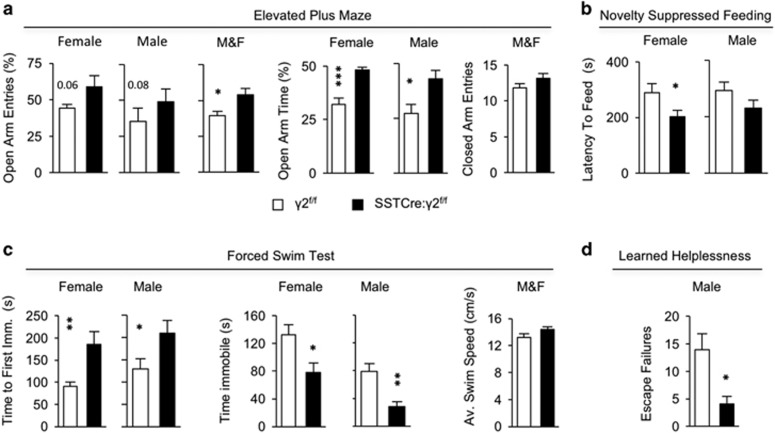Figure 4.
SSTCre:γ2f/f mice show an anxiolytic- and antidepressant-like behavioral phenotype. (a) Elevated Plus Maze: Percentage of open arm entries of SSTCre:γ2f/f mutants was increased compared with γ2f/f controls (sexes combined (M&F), F(1, 60)=6.34, P<0.05, n=29 and 35) with similar trends in females (P=0.06, n=14 and 16) and males (P=0.08, n=15 and 19). The percentage of time spent in open arms was increased in mutants vs controls in both sexes (F(1, 57)=19.16, P<0.001; male: P<0.05, n=14 and 19; female: P<0.001, n=16 and 12). The number of closed arm entries did not differ between genotypes (P>0.05, NS (non-significant), t-test). (b) Novelty Suppressed Feeding Test: SSTCre:γ2f/f mutants showed a reduced latency to feed vs controls (F(1, 62)=6.4, P=0.014), with significant effects in females (P<0.05, n=16) and a tendency in the same direction in males (P, NS; n=15 and 19). (c) Forced Swim Test: SSTCre:γ2f/f mice of both sexes showed increased latencies to their first bout of immobility (F(1, 62)=15.41, P=0.0002; female: P<0.01, n=16; male: P<0.05, n=15 and 19) and a reduced total time immobile vs controls (F(1, 62)=15.98, P<0.0001; female: P<0.05; male: P<0.01). The average swim speed during the first minute did not differ between genotypes (M&F: P, NS; n=32 and 34, t-test). (d) Learned Helplessness Test: Male SSTCre:γ2f/f mice showed fewer escape failures than controls (P<0.05, n=17 and 19, Mann–Whitney). Data represent means±s.e. *P<0.05, **P<0.01, ***P<0.001, analyses of variance and posthoc t-tests, t-tests or Mann–Whitney.

